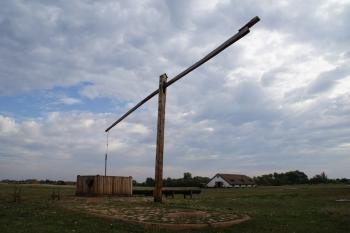
Puszta, a well-known term that is inseparably linked to Hungary. But what can be expected from this WHS? The last remains of an unspoilt cultural landscape with traces of the interaction between man and nature and pretty examples of rural architecture - sounds pretty good? Or flat and vast grasslands that looks the same in every direction, a paradise only for bird watchers - sounds rather dull and boring? To answer right away: it's a bit of both, but for me the boring parts outweigh the interesting impressions.
The village of Hortobágy is the centre of the park, here you find the visitor centre, the best-known csárda (with pretty good food), a shepherd's museum, and the Nine Arch Bridge (looks better on photos than in reality). Hortobágy has various opportunities for accommodation, we stayed for one night and were lucky to get the last available room in the hotel next to the visitor centre. There are also nice examples of vernacular architecture in and around the village and the nearby Mata Stud. The photo shows a farmhouse with an upstanding steep well, the symbol of the Puszta.
Large parts of the WHS are protected and can only be visited with a special permit and a guide, but there are three trails where the National Park is accessible (day tickets at the visitor center). First we went to the fish ponds at Halasto, a large system of artificial ponds that were created about hundred years ago, mainly for carp culture. Today the ponds are the habitat and breeding area for numerous rare water birds. We took the restored narrow gauge railway that rumbles five kilometres along the main dike up to the terminal stop, but you can also hike or ride by bike. Forty-five minutes until the ride back was more than enough time to stroll on the boardwalk through the reeds and to climb the look-out. We saw a herd of water buffalo on the train ride, but only few birds and few bird watchers. The peak season is in spring and September when migrating birds, geese and cranes, take a rest at the fish ponds. The train operator raved about a unique and memorable spectacle. Well, bird watching is not one of my greatest passions, so I'll never know.
The next day we went to the Szálkahalom trail, about eight kilometres east of Hortobágy on the road no.33, which runs right across the National Park. Just behind the parking lot is one of the kurgans, a burial mound from the Early Bronze Age. Actually just a low hill, without the information board no one would notice. Apart from that: farm buildings, small wood, and the Puszta - the main thing to see is that there is nothing to see, only the steppe soil, a few scattered trees and the horizon. We really tried to get the best out of this WHS and went to a third spot, the 'Egyek-pusztakócs', the trail starts at a parking lot about 20 kilometres west of Hortobágy. Again, a section with the characteristic salt soil and grass. The main sights are a marshland with reed and an isolated farm. But we did not go all the way, halfway we came to a fencing with gray cattle, really handsome animals with impressive horns. We took this as the highlight of the visit and returned to continue our trip.
Don't get me wrong, the Hortobágy National Park is a unique landscape. In Western Europe, similar areas have disappeared long ago due to intensive agriculture. It is worth to be protected and the inscription seems to be justified, but this WHS did not fill me with enthusiasm.
Comments
No comments yet.
